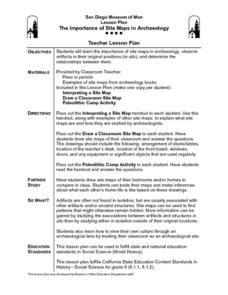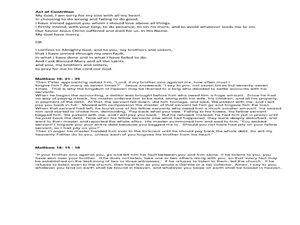Visa
Make It Happen: Saving for a Rainy Day
Every little penny counts, especially when it comes to saving for emergencies or long-term goals. Pupils evaluate different saving and investment strategies, such as a CD or money market account, through worksheets and by...
Curated OER
Abigail and John in Love
The second lesson in the series asks groups to analyze an exchange of love letters between Abigail and John Adams. Scholars identify the many allusions and references in the letters and consider what they can infer about the writers.
Curated OER
Wilson Stands Alone in His Plan for World Peace
Young scholars study the Fourteen Points. They examine motives behind Wilson's Fourteen Points and why most of them were rejected by France. They answers questions concerning primary resources (casualty list and before and after...
Curated OER
What Made George Washington a Good Military Leader?
Students identify the qualities of an effective military leader. In this Revolutionary War instructional activity, students view several Internet resources about George Washington's life. Student groups research one of four battles, and...
Curated OER
Archaeology of the Future
Pupils view pictures of classmates' homes, make list of different objects in picture, and discuss what they can tell about place from evidence in picture. Students then observe artifact pictures, and read and complete artifact chart.
Curated OER
Location, Location, Location: Using a Grid to Determine Context
Seventh graders are introduced to making inferences about artifacts. Using a grid system, they locate the artifacts and determine where they originated from. They use this information to make conclusions about the way people lived...
Curated OER
Archeology of the Future
Young scholars are introduced to the basic vocabulary of archeology. Using the vocabulary, they classify artifacts and make inferences about their uses. In groups, they create a chart for the criteria needed to analyze artifacts and...
Curated OER
Analyzing Artifacts Using Bloom's Taxonomy
Seventh graders apply Blooms Taxonomy to analyze a collection of artifacts. They define and discuss the nature of artifacts and work in groups to complete handouts. Students analyze an object (stone pipe) on a mystery artifact analysis...
Curated OER
Serach for the Lost Cave People
Students examine primary source documents to draw inferences about 17th century American colonists.
Curated OER
Japanese Objects as Cultural Artifacts: A Model Lesson Using Textiles
Pupils complete a unit on the cultural significance of textiles in the Japanese culturre. They analyze cotton, line, silk, and wool fabrics, examine various fabric creation and decoration techniques, select an object and write a detailed...
Anti-Defamation League
Shirley Chisholm: Unbought, Unbossed and Unforgotten
A 13-page packet introduces high schoolers to a lady of amazing firsts. Shirley Chisholm was the first Black woman elected to Congress, the first Black woman to run for President of the United States, and a leader of the Women's Rights...
Curated OER
Stereotypes
Students analyze then sort a given list of words by selected categories about stereotypes. They complete a list of activities then write their opinion about national stereotypes to present to the class.
Curated OER
The Study of the Spanish-Speaking People of Texas: Understanding Photo Essays
Students analyze a photo essay of the Spanish-Speaking People of Texas by the photojournalist Russell Lee. They identify the goals of the photo essay, explore a website, and complete a worksheet.
Curated OER
Digging Deeper: Mission San Saba
Seventh graders review their prior knowledge on the Spanish mission system in Texas. Using the internet, they examine the motives of the Spanish to establish missions in Texas, specifically the Mission San Saba. They research the reasons...
Curated OER
The Importance of Site Maps in Archaeology
Students consider the importance of site maps in archeology. They interpret site maps, draw site maps of their classroom and home and then participate in simulated Paleolithic archeological camp activity.
Curated OER
Mystery Cemetary: Teachers
Students examine and analyze the skeletons of various bodies that could represent a cemetary. In groups, they identify a set of common characteristics in which the skeletons are grouped. To end the lesson, they answer questions related...
Curated OER
A Treasure at our Doorstep
Young scholars write a descriptive essay about a historical landmark in their area, such as the Curtis Center in Philadelphia, PA. In this historical landmarks lesson, students use their senses to detail information about the chosen...
Curated OER
Conscience, Sin, and Correction
Twelfth graders consider the structure of the Roman Catholic Church in the Middle Ages. In this morality lesson, 12th graders examine the 95 Theses of Martin Luther and determine his reason for writing them. Students also discuss the...
Curated OER
The Study of the Spanish-Speaking People of Texas: Overcoming Adversity
Students examine the photographs of Russell Lee and identify the obstacles faced by Mexican-Americans in Texas during the early and mid-20th century. They discuss the ways they overcame these obstacles and relate it to obstacles in...
Curated OER
Living on a Cotton Farm: Mexican Americans Life In Texas
Seventh graders are introduced to the processes of cotton farming in the early 20th century. In groups, they examine the role of Mexican Americans on the farms and the impact of a boom and bust economy on cotton. They identify the...
Curated OER
Themes and Patterns of History
Fourth graders, in groups, explore recurring historical and geographical themes.
Curated OER
The Study of the Spanish-Speaking People of Texas: Daily Life
Students analyze the different ways that photography helps historians understand the lives of people who lived in the past. They examine images from Russell Lee's photo essay and discuss how Texas' has changed from an agrarian to an...
Curated OER
Digging Deeper: Mission San Sabá
Seventh graders view a painting of the destruction of Mission San Saba in Texas. They discuss the painting and identify information that they can infer from the painting.
Curated OER
Two Ways of Life
Students visit Internet sites to compare ways of life of Indians on western Texas frontier and U.S. military men at Texas forts, and draw pictures to illustrate clothing, transportation, weapons, and shelter of both Indians and U.S....























